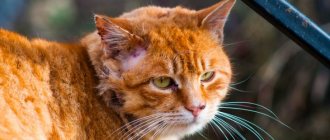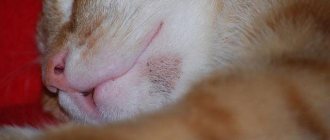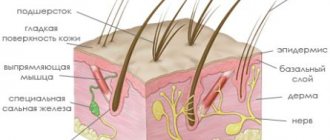Have you noticed that your cat is showing bald spots without any explanation? You may have noticed that your cat is licking certain spots more or is itching or irritated. Maybe your kitten even went potty in an unconventional way. All of these could indicate stress or health problems.
There are quite a few reasons why your cat might have bald spots, and it's best to contact your veterinarian if you notice this. However, it's best to play detective first because the more information you provide your veterinarian, the more likely he is to accurately diagnose and treat your hair loss problem.
So, what causes bald spots on cats?
Fleas
Even the best cat owners can get fleas. Fleas are sneaky and can enter your home through your clothing or other pets. They can hide in carpets and under furniture for months. And fleas can be difficult to get rid of too!
If you notice your cat chewing and itching, it may be due to fleas. Not only are fleas annoying for your cat, but some cats can develop a condition called flea bite dermatitis. This is a type of allergy to the saliva produced by fleas, which causes severe irritation when fleas bite a cat.
© shutterstock
Fleas tend to cluster at the base of cats' tails, which is a sensitive area, so this causes even more irritation. You may notice your cat chewing on the base of its tail, leaving behind bald patches. Fleas can also hang on the face, so the cat may scratch its face frequently, leaving bald patches on the neck and chin.
Fleas can be difficult to spot on cats and they are good at hiding, but there are a few things to watch out for. Fleas and flea bite dermatitis can leave behind red, bumpy skin. Additionally, fleas defecate what is essentially dried blood. If you notice rust-colored spots in your kitty's bowl, they are most likely fleas. If you notice small brown or red flakes on your cat, you can place them on a white piece of paper and drip them on top. If it's flea food, the flakes will melt again and turn into liquid blood.
Causes of hair loss in cats
Dermatophytosis, trichophytosis, lichen
By far the most common disease leading to alopecia is dermatophytosis or lichen. Most often localized on the face and head. In cats, the disease is most often caused by fungi of the genus Microsporum canis. The main symptom is that the hairs fall out on their own and are pulled out very easily, because this is an infection of the hair follicle. Important! With dermatophytosis, itching is not a common symptom! Usually lichen does not itch.
The intensity of manifestation of this disease varies - the lesions can be localized (single) and focal (several) and a generalized form (many areas) with lost hair.
Predisposition to shingles in Persian cats
Persian cats have a breed predisposition to dermatophytosis. They often have chronic recurrent or generalized lichen. In them, this disease is often severe and is somewhat different in form from other breeds. They may also have areas of skin with peeling, but without obvious alopecia. Another form of the disease they have is severe inflammation and the formation of nodules in the skin.
Diagnosis of dermaphytosis
For the diagnosis of dermatophytosis
Previously, fluorescent diagnostics using a Wood's lamp were widely used. However, it has long been proven that this method gives a large amount of error and can only serve for an initial examination. Only some types of mushrooms (about 50%) give the classic apple-green glow. Not everything that glows in a Wood's lamp is ringworm, and vice versa - not everything that glows is ringworm. To confirm the diagnosis, skin scrapings and hair are taken from areas that glowed under a Wood's lamp or from non-luminous but questionable areas and examined under a microscope. If the hair is affected, you can see hair with a destroyed structure, sometimes with fungal spores.
In complex and doubtful cases, the doctor takes the culture into a test tube with a special medium. Unfortunately, the culture takes at least 10 days to prepare, so the doctor will most likely prescribe a trial treatment in this case, because the disease is also dangerous for humans.
Treatment of lichen in cats
If the diagnosis of dermatophytosis
the doctor will prescribe not only local treatments for the affected areas, but also an oral antifungal drug (most often, in cats, this is Itroconazole / Irunin, over a long course. This drug accumulates in the hair itself, preventing the disease from developing. Using only local remedies can lead to a chronic form illness, constant relapses and infection of the apartment with spores.
Remember! Vaccines against lichen (Microderm, Polivak, Vakderm, etc.) are not used in modern veterinary medicine, their effectiveness has not been proven.
IT IS FORBIDDEN!
Some drugs, used the old fashioned way, can do more harm than good! Yam ointment, for example, is simply poisonous to cats! The waste oil, which is still widely used in rural areas, is also poisonous. And treating the affected areas with iodine leads to chemical burns and the hair in such places may not grow back at all.
There are now many modern and safe remedies for the treatment of dermatophytosis, do not self-medicate!
Parasites. Demodecosis.
Demodexes
- These are skin parasites - mites that damage the hair follicle. Previously, it was believed that only dogs suffered from demodicosis, but two types of these mites have also been isolated in cats.
Feline demodicosis
Feline demodicosis is rare. Cats have 2 pathogens - Demodex cati or Demodex gatoi.
Differences between contagious and non-contagious demodicosis:
Demodex gatoi is contagious. Infection and manifestation can occur at any age. The lesions from this mite are itchy and we will see self-induced alopecia.
Demodex cati is not contagious. Normally, they are found in small quantities on the skin of a healthy animal, being opportunistic parasites.
It appears in adult cats; alopecia is spontaneous, that is, areas with fallen hair, without itching. The cause of the manifestation is usually serious immunity disorders - immunosuppression and other serious diseases, for example, diabetes.
The most common cat diseases
Parasites almost always cause itching, and the cat begins to lick and scratch vigorously. Skin lesions and self-induced alopecia appear. The most popular diseases include:
Notoedrosis
Notoedrosis is a lesion with unbearable itching, alopecia, severe scratching and scabs, most often localized on the head and neck.
Cheyletiellosis
Cheyletiellosis - or "wandering dandruff" - looks like flaking skin, there may be hypotrichosis and areas without hair.
Otodectosis
Otodectosis is an ear mite that causes severe itching in the head and alopecia of the ears and muzzle.
lice eaters
Lice eaters are parasites that also cause hair damage and, as a result, hair loss.
Ringworm
Contrary to popular belief, ringworm is not a worm at all. Ringworm is a fungal infection often found in stray and outdoor cats. Ringworm has a characteristic round, scaly rash that appears as a bald spot. It may be red or irritated and may or may not seem to bother your cat.
Most ringworm infections are relatively easy to treat, but before trying any over-the-counter medications, it's best to consult with your veterinarian to make sure your kitten actually has ringworm. By the way, ringworm is contagious to people, and people often get ringworm from their pets.
Why the cat’s stomach and hind legs are bald: reasons
The cat's belly and hind legs are bald.
Any process of changing a cat's fur is called molting. It can be physiological or pathological. The fur on a cat's back is always thicker than on its belly. Therefore, when you lose hair, your belly will be exposed first. The cat adapts to life in a house or apartment. Typically, seasonal shedding does not occur, as in wild cats; the coat changes gradually.
So, why does the cat's stomach and hind legs become bald? The intensity of hair loss may increase for the following reasons:
- Juvenile molt . Can be observed in kittens older than 5 months . Lasts 3 months . Children's wool is replaced with new ones.
- Pregnancy and lactation . During the production of hormones, the hair on the belly falls out. Since newborn kittens suffer from a lack of warmth, it is necessary for the mother to warm them with her bare belly. And for feeding, it is also desirable that there is no hair around.
- Old age . The state of the body of older animals changes at the hormonal level. Chronic diseases appear, which often lead to the disappearance of the coat.
Standard shedding is not a serious problem. This is normal, especially if it is seasonal (spring or autumn). The cat simply changes in appearance when the temperature changes. However, if molting is accompanied by a deterioration in the cat’s well-being, a decrease in its activity and health problems appear, you need to contact a veterinarian.
Excessive grooming
When cats are stressed, they may become over-groomed and lose their fur. This stress can be caused by physical illness or changes in the environment, including new pets, moving to a new home, and even changes in food.
Cats are very sensitive to change, so try to make changes slowly. Remember to always provide your kitten with plenty of quiet places to hide, especially if you suspect stress may be related to children or other pets.
Overly groomed cats can shed hair from anywhere, but you will notice that they groom a specific area over and over again until a bald patch remains. Over-grooming is common on feet, and you may notice that your cat is losing a significant amount of hair on her front or back legs. Over-grooming can cause pain in cats, especially joint or bone pain.
If your kitty has arthritis, you may notice hair loss with the development of hot spots, which are shallow wounds created by your cat licking the same spot over and over again. Over time, hot spots can develop into mucous granulomas, which are a thickened area of skin around the hot spot as the body tries to heal the skin. Hot spots and mucous granulomas are not serious but may indicate underlying problems.
If you suspect your cat is over-grooming, assess the environment, make any changes you can make, and consult with your veterinarian to make sure there is no underlying medical problem or need for anxiety medications.
© shutterstock
What to do immediately if you discover baldness on a pet
For reference! It doesn't matter what breed the cat is, all breeds lose hair, including hair from the neck. Neither flock or velor sphinxes, nor other noble breeds, nor farm animals with stronger immunity are immune from this phenomenon.
© shutterstock
Why is this happening? In order to answer this question, you need:
- Completely examine the animal, and not only the neck, but also all its parts: ears, paws, tail.
- Pay close attention to any damage to your cat's skin. Perhaps there is no baldness there, but there are wounds similar to those on the neck.
- Analyze how you care for your pet. This may be the reason why your cat is losing hair on its neck. Therefore, it is advisable to make a list of the foods you keep your cat on. Add care products, such as shampoo, to the list. Remember and write down whether you give your cat medications: fleas, worms, vitamins, contraceptives or behavior-correcting medications.
Why is all this important? To accurately diagnose and begin treatment.
Chemicals
Some chemicals are caustic and can cause burns. If your cat gets into your garage or cleaning chemicals, you may notice hair loss accompanied by painful, rough patches of skin. If you think your cat has been exposed to hazardous chemicals, contact your veterinarian immediately.
Some cats are very sensitive to topical medications, such as flea medications. If your cat begins to lose hair in a manner consistent with how you apply her flea medication, whether in a line along her spine or points on the back of her head and at the base of her tail, she may be reacting to the topical medication. If this happens, talk to your veterinarian about your flea and tick control options. Your cat may be better off on an oral medication or a prescription collar. Always make sure you are purchasing legitimate veterinary flea and tick medications. Cheap supermarket brands are notorious for causing these reactions and much more serious reactions such as seizures. Some online pharmacies sell counterfeit veterinary products, so purchasing directly from a veterinarian is the best way to stay safe.
What measures are needed to prevent the problem?
The problem has been identified, the cat is scratching its neck and hair is coming out. And the bald patches all over the baby’s body say that you can’t cope with the problem on your own. What to do? The best thing to do is go to a veterinary clinic. An accurate diagnosis is needed. Tests and monitoring of the cat’s general condition will help you find out exactly what is causing hair loss from the kitten’s neck.
You may have to change the food or cleanse your pets of parasites. Only a doctor can decide whether vitamins or medications are needed to treat your cat.
Cat owners know that from time to time they have to collect cat hair around the house, as the period of natural hair loss begins. But why do some cats have too much fluffy cover, and even bald patches form near the tail or on the tummy and paws?
Severe hair loss is not normal; you should definitely pay attention to it and seek advice from a specialist. But don’t be alarmed right away; perhaps the animal is lacking vitamins or this is how a skin disease manifests itself.
The veterinarian will diagnose why the cat’s hair is falling out and bald spots are forming, prescribe treatment, and explain preventive measures. If the cat sheds hair, but new hairs immediately grow, then it’s just shedding season.
Allergies
Cats can be allergic to certain foods, as well as to foods they previously did well with. Systemic allergies in cats usually result in diffuse hair loss throughout the body.
Food allergies are usually linked to a specific protein, so if you think your cat has developed a food allergy that is causing bald patches, switching to a different protein food and trying it for 6-8 weeks may help. So, if your cat has been eating a chicken-based food, you may want to try a fish-based food. Read labels carefully because some products may find their way into unexpected places.
Some allergies are environmental, such as to grasses, trees, and even other animals such as dogs and people. Your veterinarian can perform allergy tests to determine what exactly your kitten is allergic to.
How to treat the disease?
To quickly cure a cat, you need to know the source of the disease and why the cat’s hair came out. If a cat suffers from baldness due to allergies, then the owner must protect the pet from the irritant. Afterwards, the cat is prescribed histamines, immune system stimulants and hypoallergenic products. If the source is parasites, then bald spots on the tail, back, and legs are treated with ointment against ticks or fleas. In addition, the veterinarian prescribes medications that improve the functioning of the immune system. For endocrine diseases, drugs are used that restore the action of the glands. If alopecia in cats is caused by an abscess, then antiseptics and antibiotics are prescribed.
Baldness of a psychogenic nature is treated with soothing drops on a natural basis.
Scabies
Mange can be contagious to other pets or benign and is not common in cats, especially cats that do not roam. If you recently adopted a stray cat, or if your cat went missing and has now returned home and you notice large patches of hair loss, talk to your veterinarian about mange testing.
Whenever you notice your cat losing hair, it is best not to touch it and wash your hands thoroughly whenever you handle the cat or its litter.
Treating a cat for parasites
Treatment must be prescribed by a doctor. Most often, complex spot-on preparations (pipettes with medicine on the skin) are prescribed in an intensive mode - every 10-14 days. The most commonly used are “Stronghold” and “Inspector”. In case of skin infection, the doctor will prescribe local treatments with antiseptic solutions and even antibiotics. Recently, information has appeared about the effectiveness of the Bravecto tablet used in dogs in cats. Studies have already been conducted and safe doses for cats have been determined. However, there is no information in the instructions yet, but it will probably appear very soon.
More serious reasons
Numerous medical conditions can lead to hair loss, including cancer, hyperthyroidism, and protein deficiency. Identifying the underlying cause of bald patches will determine the course of treatment you and your veterinarian choose.
Posted by Christian Adams An American expat living in Metro Manila, Philippines for over a decade, Christian is a lifelong cat lover and the proud father of two rescue cats, Trixie and Chloe. Both girls used to be among the crowds of homeless people who roam the cities and countryside. Three-year-old Trixie was rescued from a litter found under a neighbor's porch, and two-year-old Chloe was brought home by Christian's young son, Henry, who discovered the crying kitten in the parking lot.
The cat's stomach, hind legs, and withers are bald: what to do, how to treat it?
If a pet has health problems, it is always a worry for the owners. After all, you want to help the animal as quickly as possible. So, the cat has a bald stomach, hind legs, and withers - what to do, how to treat it? First you need to determine the cause of the disease and eliminate it:
- Check your cat's diet . Choose hypoallergenic quality food. With the right diet, you don’t even have to look for additional sources of vitamins.
- Improve the animal's living conditions . Move his bed away from the radiator and humidify the air.
- Use parasite killers . For example, Spot-on or IN-AP .
- If you are sure that the cause is an allergic reaction , tell your veterinarian.
- If the cause is stress , use sedatives, for example, Stop-Stress or Vetspokoin .
There are special vitamins for cats against hair loss. For example, brewer's yeast helps a lot. But you should not self-medicate. Be sure to visit a veterinarian. Only he will be able to establish an accurate diagnosis and choose a method of treating the animal.











